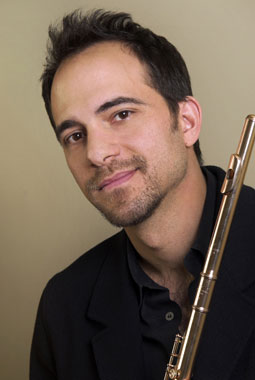by Robert Rollin

Notwithstanding the presence of the Mozart Flute Concerto, the evening’s highlight was Haydn’s Symphony No. 103, The Drum Roll. Like the later Beethoven Seventh, this is a truly great symphony that charms listener with its melodic beauty, invention, and humor. The first movement, Adagio – Allegro con spirito, justifies the symphony’s subtitle by opening with a powerful rolled timpani solo that surprisingly reappears near the final section. Otherwise it is a conventional first movement, serving up a slow introduction followed by two highly animated themes in rapid six-eight meter.
The delightful performance included an entrancing oboe solo, lovely phrasing, and exhilarating soloistic fragments exchanged among flute, oboe, clarinet, and upper strings. The timpani solo’s return heralded an Adagio theme mini-development and subsequent fragments of the two Allegro theme groups. The bassoons added an especially lovely color to the ensemble, and seemed to hint at the medieval Dies Irae theme.
The second movement, Andante, is a series of variations on two themes, the first, major and the second, minor. The two themes, though different from one another, are united in an ascending melodic profile followed by an immediate descent. The concertmaster had a beautiful filigreed variation that McGegan balanced masterfully with the accompaniment. Again the bassoons were entrancing, and there was an inventive exchange between the clarinet and the cello section.
The good humored and rhythmically inventive Minuet had fine playing by horns and woodwinds. The Finale, Allegro con spirito, is monothematic, but keeps changing in a developmental kaleidoscope. The performance was stunning because of its varied dynamics kept in fine balance by MeGegan.
Domenico Cimarosa’s The Secret Marriage was among the most popular of his 76 operas. This Neapolitan composer specialized in hugely successful comic operas. The Overture is a short gem for large orchestra that featured lots of timpani, an imaginative chromatic second theme, and wonderful playing by violins, horns, and oboe. There was a grace-noted moment in the oboe that sounded like a bird chirping, and a delightfully surprising, sudden complete silence prior to the final rush to conclusion.
The Orchestra also presented two charming Mozart works. The Symphony No. 33 in B-flat major, K. 319, is dated, Salzburg, 1789. Prior to moving to Vienna, Mozart’s symphonies were in three movements. In the next decade he added a Minuet and Trio movement to make Symphony No. 33 palatable to Viennese audiences. This movement featured nice use of paired horns and a lively oboe solo. The first movement, Allegro assai, had rhythmically interesting syncopated accompaniments and rapid triplet figures. The restrained Andante possessed quiet nocturnal charm, and the Finale, Allegro assai, an imaginative development that explored minor keys.

Published on ClevelandClassical.com July 23, 2013
Click here for a printable version of this article.


